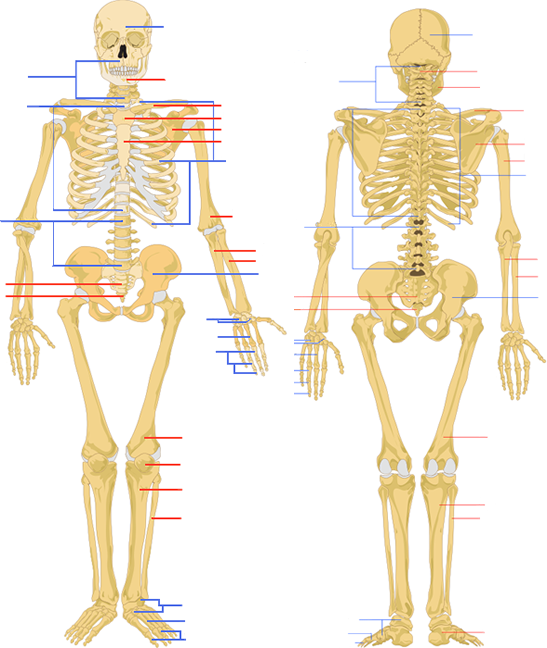Skeletal system review key:
What is the skeletal system?
Includes bones, which are living tissues and connective tissues that (plus three or more of the following) support, protect, shape, provide a structure, frame, make red and white blood cells.
Name functions of the skeletal system.
- Supports the body and protects its internal tissues and organs from damage.
- Gives the body shape.
- Provides structure for the body.
- Provides a frame for the body to attach bones and muscles so they can interact for movement.
- Produces red and white blood cells (Leukocytes).
- Stores fat and minerals (calcium and phosphorus).
Parts and functions
Match the words in the word bank to the function and label the diagram.
- ___ ribs _______ protects the heart and lungs.
- ___ bone (tissue)__ hard objects made of living cells and minerals.
- ___ bone ________ cells that are hard structures to supports and protect the body.
- ___ joints _______ where bones join together.
- ___ skull _____ protects the brain
- ___ calcium _______ an important mineral needed for healthy bones.
- ___ dairy _______ A class of foods high in calcium.
- ___ fixed _____ the kind of joint that moves very little and give an example (skull & ribs).
- ___ ball & socket ___ the kind of joint that moves bones in large circles (shoulder & hip).
- ___ ellipsoidal _________ the kind of joint that has a twisting side to side and back and forth motion (metacarpals & phalanges).
- ___ dislocation ____ is when the bone slips from the socket tearing ligaments that attach the bone at the joint.
- ___ marrow ________ substance in the center of bones.
- ___ hinge ___ joint with back and forth movement (fingers, ankle, elbow, knee).
- ___ ligament ______ strong tough fibers that hold bones together at the joints.
- ___ sprain ________ injury where ligaments tear or stretch away from the bones.
- ___ fracture ________ A crack or break in a bone.
- ___ hairline fracture ________ A break where the bones are not separate.
- ___ compound ________ A break in a bone with the bone protruding from the skin.
- ___ tendons ________ attach muscle to bone.
- ___ arthritis ______ an inflammation of the joint from normal wear, injury, or autoimmune disease.
- ___ scoliosis _____ a curvature of the spine.
Label 10 bones on the skeleton diagram
 Skeletal illustrations modified from Lady of Hats, Mariana Ruiz Villarreal
Skeletal illustrations modified from Lady of Hats, Mariana Ruiz Villarreal
Word bank
arthritis, compound, ball & socket, ellipsoidal, skull, bone, tendons, dairy, ligament, skin, joints, hairline, fixed, scoliosis, nails, calcium, epidermis, blood vessels, ribs, marrow, sprain, hinge, fracture, hinge, dislocation, repetitive motion, carpals, metacarpals, phalanges, femur, patella, tibia, fibula, tarsals, phalanges, humerus, ulna, radius pelvis, vertebrae, coccyx, cranium, ribs, scapula, mandible
Ways to care for bones and related tissue.
- Good nutrition particularly foods with calcium, vitamin D, and phosphorus.
- Weight bearing exercise (weight training, walking, jogging, ...)
- Wearing protective gear (shin guards, knee guards, elbow guards, helmets, and pads).
Describe two health related care issues
- Fracture is a break in a bone. Different types of fractures include:
- Hairline fracture is when the broken parts do not separate.
- Transverse fracture is completely across the bone.
- Comminuted fracture is when the broken parts include more than two pieces.
- Compound fracture is when the bone is exposed through the skin.
- Scoliosis is curvature of the spine. Can be front to back (lateral) or side to side.
- Dislocation is when the bone slips from the socket tearing ligaments that attach the bone at the joint. Doctor will reset the bone and immobilize it till the ligaments heal.
- Torn cartilage may require arthroscopic surgery to remove and repair the damage.
- Arthritis is an inflammation of the joint from normal wear, injury, or autoimmune disease.
- Bursitis is pain in the joints caused by inflammation of the fluid between the bones at a joint.
- Bunion is swelling between the toe joints. Caused by inflammation of the fluid between the joints from poor fitting shoes.
- Repetitive motion injury, such as carpal tunnel syndrome, is caused by damage to the ligaments and tendons from factory work, computer use or other prolonged movements. Can result in swelling, numbness, weakness, tingling sensation and pain.